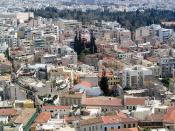Athens emerged from the Dark Age as an agricultural economy. The cityÃÂs orientation and their harbors made Athens famous as a mercantile and seafaring polis. Aristocratic dominance rested on the elected magistracies and the council of state. In the early seventh century, Archons (aristocratic officials) were the executive power over Athens. Nine Archons presided over the functions of the polis. Each would serve a term of one year and then they became permanent members of the Areopagus Council. The Council elected the Archons which gave them control of their futureÃÂs membership. During the seventh century the population fell to debt slavery. The polis began to weaken even more with rivalries between aristocratic political factions. In 621 B.C.E. when Drakon failed to stabilize Athens, Solon, a merchant, was given the power to reorganize the government in 594 B.C.E. Solon laid the foundation for Athenian Democracy. He didnÃÂt allow slavery and land was used to buy back debt slaves.
The commercial power was restored when he encouraged the Athenians to grow olives and grapes. Solon set up courts which allowed a broader range of citizens to become jurors. This allowed them to appeal decisions of the Areopagus. Solon also gave the Athenians the right to elect the archons (akklesia). His reforms did not succeed and resulted in turmoil.
In 546 B.C.E., Peisistratos became the new tyrant and strengthened the common people while enforcing SolonÃÂs reforms. After his death, the Athenians overthrew the government. Cleisthenes, who served under Peisistratos, then became leader. He took steps to limit aristocratic power. The Athenians could then decide whether or not they wanted someone to serve. He established the practice of Ostracism, where they could banish someone; this allowed them to prevent any returns of tyrants.
Sparta brought four villages together formed a polis. They were...


